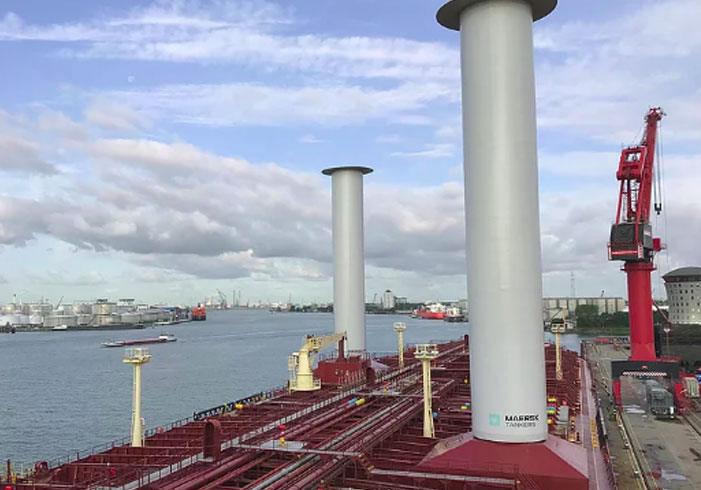According to the Cass Freight Index, “Shipment volumes in the US by truck, rail, air freight, and barge combined surged 11.9% year-over-year in March.” That surge put the level at its highest since 2006. With this surge has come an increase in costs. For example, the cost of fuel has erupted.
Starting in 2017, the cost of diesel fuel increased 75% year over year. And although that increase in price is now diminishing to less than 18%, those in the shipping industry are still searching for ways to cut costs. After all, fuel isn’t the only fluctuating expense those in the industry deal with.
Maersk’s Solution
Maersk Tankers’ solution to the fuel problem is to harness a different form of energy: wind. Since sailboats have been using wind to propel themselves for thousands of years, it seems like a simple enough solution. In fact, it is extremely complex.
Shipping vessels aren’t built the same as sailboats. They are much heavier and less ergo dynamic. That’s why Maersk Tankers’ sails don’t actually look like sails, they simply function like them.
In reality, they are 100-foot-tall cylinders that rotate to produce energy. Currently, the Danish shipping giant only has one ship equipped with the new technology (the Maersk Pelican). They are hoping to roll it out to their entire 164-tanker fleet soon, though.
The technology behind the cylinders comes from the Magnus effect. It states that “a spinning object drags air faster around one side, creating a difference in pressure that pushes the vessel in the direction of the lower-pressure side.”
Maersk isn’t the first company to attempt something like this. A French explorer named Jacques-Yves Cousteau had a vessel equipped with turbo-sails in the 1980s.
Maersk’s cylinders are different, though. They are made of a composite of materials based on Norsepower Oy Ltd.’s designs, a company located in Finland. The total cost to fit a single vessel is anywhere between $1.2 million and $2.3 million.
These sails have undergone rigorous testing on land. Now, they will be “the first rotor sails to be Class approved for use on a product tanker.” (Energy Manager Today)
This isn’t brand new technology, though. The sails have actually been used since 2014. However, they were only fitted to a ferry. There is a lot of recalculation involved when transferring the technology to much larger and heavier vessels.

Outlook for the Launch
Although Maersk didn’t disclose their annual energy bill, estimates of their fuel spending are around $3.4 billion for a fleet of 800. If the sails project isn’t fully functional by 2020, those costs will raise $2 billion. That’s due to the need to comply with rules that will require the company to use clean fuels. Additionally, marine fuel prices have already increased 30% for last year. That’s why Maersk is banking on these sails working.
If they do, the company’s fuel consumption could be cut by 7% to 10% on the ships equipped with the technology. The company is ready to move forward with the project…if these numbers hold up in testing. They plan on equipping 80 ships with the new sails as soon as possible.
The Pelican will be one of the first of its kind to potentially yield real results. Other companies have tried similar technologies in the past but the savings yield was always too low or the costs were too high.
If successful, the Pelican’s fuel bill will be cut by up to 10%. Anyone in the shipping business knows how much savings that could be, especially if other vessels are equipped with the same technology.
Impact on the Shipping Industry
The main impact this innovation will have on the shipping industry is clearly fuel savings. If this or similar technology can be developed by all shipping companies, then everyone will save exponentially on fuel.
This, of course, will also help the environment. However, it may also stall the economy. With such a sharp decrease in fuel purchases, the fuel industry may have difficulty recovering.
On the other hand, other companies could be years off from developing this sort of technology for themselves. That means that only a few companies will be left with this advantage. That could create a wormhole in the shipping industry where there are a few companies that strive while the rest fight to stay afloat.
This is a worst-case scenario, though. Most likely the technology will be spread fairly evenly over companies. With rising oil prices, this will be essential. Fuel prices themselves are going to rise by $24 billion in 2020.
So, this new technology is actually an answer to two problems: how to economically ship the increased number of goods in demand and decrease environmental impact.
Moving Forward
Maersk is on the right track when it comes to new innovations that help cut costs and save the environment. On one hand, cutting costs is going to give you an edge in the shipping market. If you are spending less, then you can charge less.
On the other hand, being better for the environment also gives you a leg up. Certain companies may choose an exclusive shipping company simply because they are environmentally friendly. It helps their bottom line and it makes them look good.
Being innovative is another key that Maersk discovered. With so many technological innovations coming to fruition, having something unique is what will make you stand out. So, be innovative, environmentally friendly, and cut costs. That’s how you survive in the modern shipping world.


2 Comments on “Maersk Uses Renewable Energy to Battle Rising Fuel Costs”
The post was Helpful. Thanks for this!
Hello – We are glad you enjoyed it. Thank you for reading us!